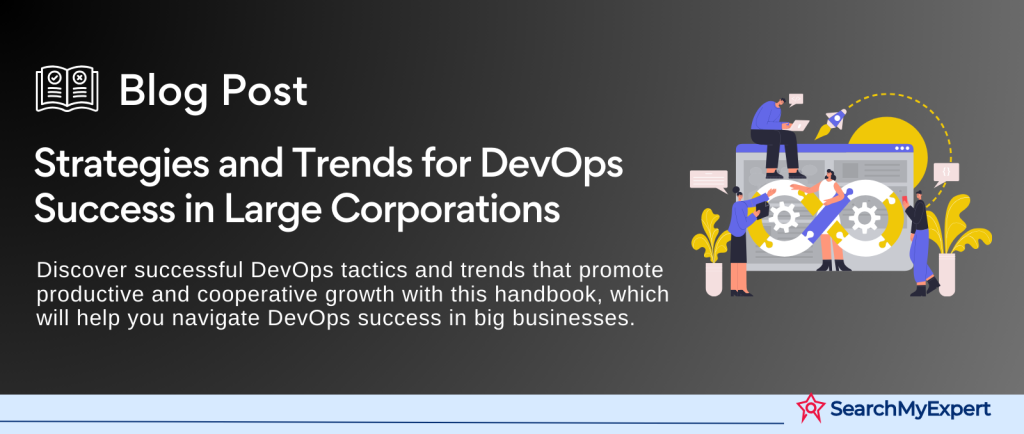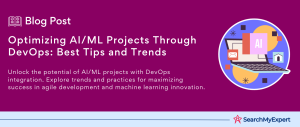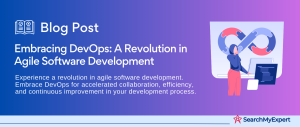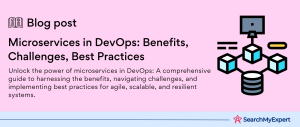Understanding DevOps in Large Organizations: Challenges, Opportunities, and Benefits
DevOps, a portmanteau of “Development” and “Operations,” is a set of practices, tools, and cultural philosophies that foster collaboration and communication between software developers and IT professionals. In large organizations, this amalgamation aims to streamline the process of software development and infrastructure management, making the deployment of software faster and more efficient.
Core Principles of DevOps in Large Enterprises
- Collaboration and Communication:
Central to DevOps is the breakdown of silos between teams. In large organizations, where departments often operate independently, fostering a culture of open communication and collaboration is crucial. This integration ensures that developers, operations teams, and other stakeholders work together seamlessly throughout the software development lifecycle. - Automation:
Large organizations handle vast amounts of data and complex processes. DevOps emphasizes automation in testing, integration, and deployment, which enhances efficiency, reduces human error, and speeds up the delivery of software products. - Continuous Integration and Continuous Delivery (CI/CD): DevOps promotes the practice of regularly merging code changes into a central repository, followed by automated testing and deployment. This approach, particularly important in large-scale environments, ensures that the software can be reliably released at any time.
- Monitoring and Feedback: Continuous monitoring of applications and infrastructure in real-time allows large organizations to quickly identify and rectify issues. This immediate feedback loop is essential for maintaining the quality and performance of software systems.
Unique Challenges in Implementing DevOps in Complex Enterprises
Implementing DevOps in a large organization comes with unique challenges:
- Cultural Shift:
Changing the organizational culture to embrace collaboration, openness, and rapid iteration can be a significant hurdle in traditionally siloed and hierarchical enterprises. - Scalability: The tools and processes that work for smaller teams may not be effective at scale. Large organizations require solutions that can handle complex, multi-faceted operations without sacrificing performance.
- Legacy Systems: Integrating modern DevOps practices with existing legacy systems and processes can be complex and resource-intensive.
- Security and Compliance:
Large enterprises often have stringent security and compliance requirements. Integrating these requirements into the DevOps pipeline without hindering speed and agility is a delicate balance.
Key Benefits of Successful DevOps Integration
- Improved Efficiency and Productivity:
Automation and streamlined workflows reduce manual efforts and lead to more efficient processes. - Enhanced Agility:
DevOps enables organizations to respond faster to market changes and customer needs, providing a competitive edge. - Higher Software Quality:
Continuous integration and testing mean issues are identified and resolved earlier in the development process, leading to higher-quality software. - Better Collaboration: Breaking down silos improves teamwork across departments, leading to more innovative and effective solutions.
- Faster Time to Market: With more efficient processes, organizations can reduce the time from development to deployment, bringing products to market faster.
Scaling DevOps Practices in Large-Scale Enterprise Projects
Scaling DevOps practices in large organizations is a complex task that involves extending agile methodologies and automation tools to accommodate larger, more diverse, and often geographically dispersed teams. The key is not just about scaling up the tools and processes, but also about cultivating a culture that embraces these changes.
Challenges in Scaling Agile and Automation
- Complexity in Project Management:
As projects grow in size, managing them with agile methodologies becomes more complex. Larger teams and projects can lead to fragmentation, making it difficult to maintain the agility and flexibility that smaller teams enjoy. - Integration of Diverse Tools: Large organizations often use a plethora of tools. Integrating these tools into a cohesive workflow that supports DevOps practices can be challenging.
- Customization of Automation:
Automation tools that work well for small teams might not scale effectively for enterprise-level projects. Customizing these tools to handle more complex workflows and larger data sets is essential. - Training and Skill Development:
Scaling DevOps requires staff to be trained in new tools and methodologies. In a large organization, ensuring everyone is up to speed and capable of adapting to new workflows is a significant undertaking.
Strategies to Overcome Organizational Silos
- Cross-Functional Teams:
Create teams that include members from development, operations, and other relevant departments. This promotes a better understanding of different perspectives and fosters collaboration. - Regular Communication:
Encourage regular meetings and open communication channels among different teams. This can be facilitated through the use of collaborative tools and platforms. - Shared Objectives and Metrics:
Align teams with shared goals and metrics to encourage a unified approach towards project outcomes, rather than working in isolated silos.
Robust Governance and Compliance in DevOps
- Standardization of Processes:
Establish clear standards and practices for development and deployment. This helps in maintaining consistency and quality across the enterprise. - Compliance as Code:
Integrate compliance and governance requirements into the codebase from the beginning. This approach, often referred to as “compliance as code,” ensures that these requirements are automatically considered in every phase of the development process. - Automated Security and Compliance Checks:
Utilize automated tools to continuously monitor and enforce security and compliance standards throughout the DevOps pipeline. - Audit Trails and Documentation:
Maintain comprehensive audit trails and documentation. This is crucial not only for compliance purposes but also for analyzing and improving DevOps practices. - Continuous Improvement:
Regularly review and update governance and compliance frameworks to keep up with evolving regulatory requirements and industry best practices.
Essential DevOps Tools and Technologies for Large Enterprises
In the realm of DevOps, various tools and technologies play pivotal roles in streamlining and optimizing the software development and deployment processes. For large enterprises, choosing the right set of tools is crucial for ensuring scalability, reliability, and efficiency.
Key DevOps Tools and Technologies
- CI/CD Pipelines:
Continuous Integration/Continuous Delivery pipelines are at the heart of DevOps. Tools like Jenkins, GitLab CI, and CircleCI automate the process of integrating code changes and deploying them to production, ensuring fast and reliable delivery. - Configuration Management: Tools like Ansible, Puppet, and Chef help in automating the configuration and management of software and infrastructure. They ensure consistency across environments and help in scaling operations efficiently.
- Containerization Platforms: Docker and Kubernetes have revolutionized the way applications are deployed. Containerization encapsulates applications in containers, ensuring consistency across environments, while Kubernetes automates container orchestration, enhancing scalability and reliability.
- Version Control Systems:
Git is a fundamental tool for version control, allowing teams to track and manage changes to code, collaborate without conflicts, and maintain a history of changes. - Monitoring and Logging: Tools like Prometheus, Nagios, and ELK Stack (Elasticsearch, Logstash, Kibana) provide insights into the performance of applications and infrastructure, helping in proactive issue resolution and performance optimization.
Considerations for Tool Integration in Complex IT Infrastructures
- Compatibility: Ensure that the chosen tools integrate seamlessly with existing systems and technologies in the enterprise.
- Scalability:
The tools must be able to handle the scale of operations and grow with the enterprise. - Security and Compliance: Tools should adhere to the security protocols and compliance requirements of the enterprise.
- Ease of Use and Support: Consider the learning curve and the level of community or vendor support available for these tools.
- Cost-effectiveness: Evaluate the cost implications, including licensing and maintenance costs.
The Role of Open-Source Technologies in DevOps
- Cost Efficiency:
Open-source tools often come without the licensing costs associated with proprietary software, making them a cost-effective option for large enterprises. - Community Support: Open-source projects benefit from the support of a global community of developers who contribute to the continual improvement of the tools.
- Flexibility and Customization:
Open-source technologies can be freely modified and tailored to fit the specific needs of an enterprise. - Innovation: The open-source ecosystem encourages innovation through community collaboration, often leading to the rapid development of new features and tools.
- Transparency and Security:
Open-source software offers transparency, allowing enterprises to inspect the code for security vulnerabilities and compliance.
Cultivating a DevOps Culture for Success in Large Enterprises
Implementing DevOps in large organizations transcends the mere adoption of tools and technologies; it necessitates a fundamental shift in culture. This cultural transformation is pivotal in ensuring the success of DevOps initiatives, and fostering an environment of collaboration, shared responsibility, and continuous improvement.
The Role of Culture Change in DevOps
- Fostering Collaboration: DevOps culture breaks down silos between development, operations, and other departments, promoting a collaborative environment where knowledge and skills are shared.
- Embracing Automation:
Automating repetitive tasks frees up valuable resources, allowing teams to focus on more strategic, innovative activities. - Cultivating Shared Ownership: In DevOps, the responsibility for the software’s quality and reliability is shared across the entire team, not just a single department.
- Learning from Failures:
A DevOps culture encourages learning from failures and viewing them as opportunities for growth and improvement.
Building a DevOps Culture in Large Organizations
- Comprehensive Training:
Provide training and resources to educate employees about DevOps practices and tools. This includes not just technical training but also workshops on collaboration and communication. - Encouraging Open Communication:
Establish channels for open, transparent communication across different teams. Regular meetings, stand-ups, and collaborative platforms can facilitate this. - Setting Performance Metrics:
Define clear, achievable metrics that align with DevOps goals. These metrics should not only focus on technical aspects but also on the efficiency and effectiveness of collaboration and processes. - Leadership and Management Support:
Leaders and managers should actively support the DevOps transformation, demonstrating commitment and setting an example for the rest of the organization. - Recognizing and Rewarding Collaboration:
Acknowledge and reward behaviors that promote the DevOps culture, such as teamwork, problem-solving, and proactive communication.
Continuous Improvement and Measurement in DevOps
- Feedback Loops:
Implement mechanisms for continuous feedback at every stage of the DevOps lifecycle. This includes feedback from the end-users, as well as internal feedback among team members. - Learning from Data:
Use data from monitoring and reporting tools to identify areas for improvement. Analyzing trends and patterns can provide insights into both successes and failures. - Iterative Development:
Embrace an iterative approach to both software development and process improvement, allowing for incremental changes and quick adaptation. - Regular Retrospectives: Conduct regular retrospectives to discuss what worked, what didn’t, and how processes can be improved. This should be a blame-free environment focused on constructive feedback.
- Staying Current with Industry Trends: Keep abreast of the latest developments in DevOps practices and tools. Encourage innovation and experimentation within the team.
Integrating Security and Compliance in the DevOps Pipeline for Large Enterprises
Incorporating security practices into the DevOps pipeline, often referred to as DevSecOps, is a crucial element for large enterprises. It involves embedding security at every stage of the software development lifecycle, ensuring that security and compliance are not afterthoughts but integral components of the process.
Challenges of Integrating Security in DevOps
- Shifting Security Left:
Traditional models often see security checks occurring late in the development process. The challenge is to ‘shift left’ – integrating security early and continuously throughout the DevOps cycle. - Balancing Speed and Security: DevOps emphasizes rapid development and deployment, which can sometimes be at odds with the thoroughness required for robust security practices.
- Complexity of Enterprise Systems: Large enterprises often have complex IT infrastructures, making the uniform application of security practices across all systems challenging.
- Cultural Hurdles: Integrating security into the DevOps process requires a cultural shift where all team members take responsibility for security, moving beyond the notion that security is only the concern of specific teams.
Building Secure Software with DevSecOps Principles
- Automated Security Testing: Integrate automated security testing tools into the CI/CD pipeline. Tools like static application security testing (SAST) and dynamic application security testing (DAST) should be used to identify vulnerabilities early.
- Code Analysis:
Implement code analysis tools to review source code for security vulnerabilities as part of the development process. - Security Training: Equip development and operations teams with the necessary security training. This will help them identify potential security issues and adhere to best practices.
- Incident Response Planning:
Develop and practice incident response plans. This ensures that teams are prepared to quickly and effectively handle any security breaches.
Ensuring Compliance within a DevOps Environment
- Compliance as Code: Embed compliance requirements into the codebase. This approach ensures that compliance is automatically enforced at every step of the software development lifecycle.
- Continuous Compliance Monitoring:
Implement tools that continuously monitor compliance, providing real-time feedback and alerts for any deviations. - Documentation and Auditing:
Maintain comprehensive documentation of all processes and changes. Automated logging and record-keeping facilitate easier auditing and compliance verification. - Regular Review and Updating of Compliance Standards:
Stay abreast of changes in regulatory requirements and update compliance standards accordingly. This should be a part of the continuous improvement process in DevOps. - Collaboration with Compliance Teams:
Encourage regular communication and collaboration between DevOps teams and compliance/legal experts within the organization to ensure that all software development aligns with regulatory requirements.
Case Studies of Successful DevOps Implementation in Large Enterprises
GitHub: Empowering Developers through Automation
GitHub, a platform known for hosting software development and version control using Git, showcases a significant success story in DevOps implementation. By prioritizing developer empowerment, GitHub provided tools and processes that enabled developers to own their projects from end to end. This culture of ownership, combined with extensive automation, allowed GitHub to scale rapidly while maintaining a reliable, high-quality service. The key to their success was fostering a strong DevOps culture that emphasized collaboration, communication, and automation.
Slack: Optimizing Collaboration and Communication
Slack, since its inception in 2013, has transformed team communication and collaboration. Their commitment to DevOps principles, including their focus on automation and monitoring, played a pivotal role in their success. Using their own product to foster cross-functional communication, Slack broke down silos and ensured alignment on project goals across teams. Slack’s CTO, Cal Henderson, highlighted how a strong DevOps culture was instrumental in their rapid growth and ability to continuously improve the product.
U.S. Department of Homeland Security: Enhancing Cybersecurity with DevOps
The U.S. Department of Homeland Security (DHS) embarked on adopting DevOps practices to modernize its IT infrastructure. A key initiative was the Continuous Diagnostics and Mitigation (CDM) program, which aimed to provide a comprehensive cybersecurity framework. Integrating DevOps principles led to significant improvements in deployment times and collaboration between cybersecurity and IT teams, enhancing the department’s ability to respond to threats and protect critical systems.
UK Government Digital Service: Transforming Government Services
The UK Government Digital Service (GDS) is another example of successful DevOps implementation in the public sector. They played a crucial role in the digital transformation of government services, including the creation of GOV.UK. This platform was built using DevOps practices, allowing GDS to streamline development, ensure consistent performance, and maintain high security. This case study highlights how DevOps can be effectively used in government sectors to improve service delivery and operational efficiency.
Yahoo Answers: Revitalizing a Large Consumer Website with Agile and DevOps
Yahoo Answers, facing stagnation in 2009, underwent a significant transformation with DevOps and Agile methodologies. Key leaders across Engineering, Product, Design, and Operations collaborated to revitalize the platform. They focused on key metrics and consolidated teams to improve communication and collaboration. As a result, they achieved a 72% growth in traffic, 3x user engagement, and 2x revenue increase. Their transition to daily releases and improved site performance was a testament to the power of Agile and DevOps in turning around a large-scale digital property.
A Large, Regulated Industry: Embracing CI/TDD and Full Agile Stack
In another case study, a large regulated industry with approximately eight thousand IT staff and two thousand applications faced challenges in delivery consistency and quality. A senior vice president initiated an experiment to demonstrate the effectiveness of Agile practices. They established consistent Agile management practices across all technologies and adapted engineering practices based on technology needs. The results were impressive, leading to increased consistency in delivery and quality, demonstrating the scalability and impact of DevOps in a large, regulated environment.
Harnessing the Future of DevOps: Key Takeaways and Emerging Trends
As we conclude our comprehensive exploration of DevOps in the context of large enterprises, it’s clear that DevOps is not just a set of practices or tools, but a fundamental shift in how organizations approach software development and operations. This transformation is pivotal for businesses aiming to thrive in today’s fast-paced digital world.
Key Takeaways from DevOps in Large Enterprises
- Cultural Transformation is Vital:
Successful DevOps implementation goes beyond technology; it requires a cultural shift towards collaboration, shared responsibility, and continuous improvement. - Scaling Challenges and Solutions:
While scaling DevOps in large enterprises presents unique challenges, strategies like embracing automation, fostering cross-functional teams, and integrating robust security and compliance practices are key to overcoming these hurdles. - Continuous Improvement and Learning:
DevOps is an ongoing journey of improvement, emphasizing the importance of learning from failures, iterating processes, and constantly enhancing collaboration and efficiency. - Security and Compliance Integration:
Embedding security and compliance into the DevOps pipeline, a practice known as DevSecOps, is crucial for maintaining the integrity and reliability of software in large enterprises. - Real-World Success Stories:
Case studies from companies like GitHub, Slack, and the U.S. Department of Homeland Security underscore the transformative potential of DevOps in achieving remarkable improvements in efficiency, security, and market responsiveness.
Emerging Trends and Advancements in DevOps
Looking ahead, the DevOps landscape continues to evolve, with several key trends and advancements shaping its future:
- AI and Machine Learning Integration: The integration of AI and machine learning is poised to revolutionize DevOps, offering predictive analytics for better decision-making, automated code reviews, and enhanced performance optimization.
- Increased Emphasis on Security: As cybersecurity threats become more sophisticated, DevOps will increasingly focus on integrating advanced security measures into the development lifecycle.
- Serverless and Cloud-Native Technologies:
The rise of serverless computing and cloud-native technologies offers new opportunities for scalability and efficiency in DevOps practices. - Infrastructure as Code (IaC):
IaC will continue to be a key element, enabling teams to manage and provision infrastructure through code, enhancing consistency and reducing manual errors. - Microservices Architecture:
The shift towards microservices architecture facilitates more modular, scalable, and manageable application development, aligning well with DevOps principles.
A Call to Action for Embracing DevOps
For organizations yet to embark on their DevOps journey, the message is clear: embracing DevOps is no longer an option but a necessity for remaining competitive and agile in an increasingly digital world. DevOps offers a pathway to faster, more efficient, and higher-quality software development, fostering innovation and responsiveness to market needs.
Conclusion:
DevOps presents a transformative opportunity for large enterprises, offering a roadmap to enhanced efficiency, agility, and innovation. By embracing a culture of collaboration, integrating cutting-edge technologies, and adhering to best practices in security and compliance, organizations can effectively navigate the challenges of scaling DevOps. The success stories and emerging trends in the DevOps landscape, including the integration of AI and machine learning, provide a glimpse into a future where continuous improvement and technological advancement drive business success. Enterprises poised to embark on this journey must seize the opportunity to revolutionize their software development and operations, positioning themselves at the forefront of the digital age.
Collaborate with expert DevOps Service Agencies for advanced DevOps strategies.
Table of Contents
Toggle






